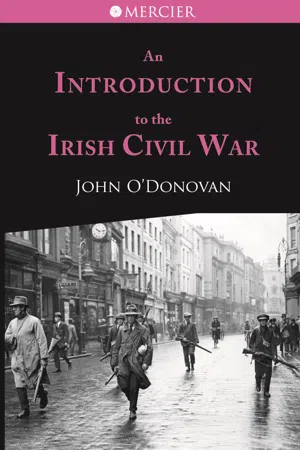![]()
Phase 1
With the noise of the shells raining on the Four Courts ringing in their ears, Republican IRA leaders met at the Clarence Hotel across the River Liffey. De Valera, Brugha, Lynch, Moylan, Deasy, P.J. Ruttledge and new chief of staff Maurice (‘Moss’) Twomey attended, along with offiers of the Western Division. The decision to support the Four Courts garrison was swiftly arrived at, after which Lynch, Deasy, Seán Moylan, Con Moylan, Twomey and Seán Culhane set out for Kingsbridge Station to catch a train for Mallow. On their way, they were halted by a squad of National Army troops under the command of Liam Tobin, placed under arrest, and taken to Wellington Barracks on Dublin’s South Circular Road. There Eoin O’Duffy questioned them before they were released and allowed continue their journey.
At the Four Courts, the shelling continued for two further days. On 30 June, the building caught fire and spread quickly to adjoining buildings. The Public Record Office, containing thousands of precious documents dating back to 1174, was destroyed in an explosion. O’Connor and the garrison surrendered and were lined up on the quay outside to be marched to Mountjoy Jail. On the way six, including O’Malley, escaped.
An impromptu coalition of Labour Party leader Thomas Johnson, lord mayor of Dublin Laurence O’Neill and the Catholic archbishop of Dublin Edward Byrne twice attempted in the first weeks of fighting to bring about a truce. On both occasions, their overtures were rejected by the Provisional Government, which had determined at a meeting on 1 July ‘that the attack on other Irregular [Republican] strongholds should be vigorously continued’. A further attempt by a large delegation of women from across the political divide led by Maud Gonne, Hannah Sheehy-Skeffington, Louie Bennett and Rosamund Jacob to mediate between Traynor and Griffith was rejected by the latter. Mulcahy was given de facto com-mand of the National Army, with Collins assuming the portfolio of Minster for Defence while continuing to act as commander-in-chief.
Following their escape from the Four Courts, Dublin Republican IRA members under the command of Oscar Traynor seized several buildings in Sackville Street, Parnell Street, and Capel Street. Other buildings were later taken overlooking Gardiner Street, Lower Abbey Street, and the ruins of the Customs House. Together these streets acted as the boundaries of a cordon in the north inner city. Traynor’s headquarters was in ‘The Block’ on Marlborough Street.
In the defence of this cordon, women played a promi-nent role. Constance Markievicz acted as a sniper from the roof of a building on Earl Street, Delia Larkin ferried ammunition to snipers on City Quay, and many members of Cumann na mBan (including Máire Comerford, Nora Connolly and her sister Ina) worked as nurses, drivers and messengers. In his memoirs O’Malley expressed his admiration for women practising their driving skills under heavy barrage: ‘[T]hey practised gear changes up and down streets, and back lanes until they felt themselves sufficiently skilled to act as despatch carriers’. Madge Clifford worked as a secretary to the Four Courts garrison, issuing proclamations and declarations. After the fall of the buildings, she escaped with O’Malley and continued working as his secretary.
Outside Dublin, Republicans mobilised to relieve Traynor. The South Dublin and Mid-Kildare brigades rallied in and around Blessington. O’Malley mobilised several brigades in Tipperary to join them. Together these units were to march on Dublin, their objective being the capture of the Provisional Government’s seat in the Royal College of Science on Merrion Street.
These plans failed, because on 2 July the National Army attacked Traynor’s positions in and around ‘The Block’. Although Republicans fought hard, for example around the Swan public house on York Street, many evacuated south across the Liffey. Those that remained surrendered outside the Hammam Hotel on 5 July. Controversially, Cathal Brugha was shot in the leg at some stage during this surrender; he died two days later. His death came as a shock to many in the Republican leadership, but it was not the only controversial episode during this period of fighting. National Army officers alleged that Republicans used the Red Cross flag as cover for military operations, including using nursing stations as military posts and having vehicles em- blazoned with the Red Cross flag and logo smuggling guns and ammunition out of the city.
From 7 to 10 July 1922 Republicans and National Army units fought across three counties to the south and west of Dublin: Kildare, Wicklow and Wexford. Sporadic fighting broke out in Kilkenny also.
A pause in the fighting followed. At the start of August, Republicans attempted to cut off communications between Dublin and the rest of the country via a series of attacks called ‘the night of the Bridges’. These attacks were foiled when a raid in Rathfarnham uncovered the plans. The following night 100 Republican soldiers were captured. Follow-up searches in Wicklow led to fifty-five more arrests. By the end of the month, another 310 Republicans had been captured in the city and county.
Once the initial fighting in Dublin had subsided, the focus on both sides switched to Munster. From July to September 1922, some of the most prolonged fighting of the war took place in the province. National Army forces from Dublin attacked from two directions. Units from Dublin and Kilkenny moved south to Waterford and west through Tipperary. At the other end of the province Brennan’s FWD combined with units travelling from Kildare, Leix and King’s County to battle for Limerick city before turning south and west towards Cork and Kerry. On the Republican side, Liam Lynch (who had succeeded Moss Twomey as chief of staff) moved GHQ from Dublin to Limerick shortly aft...

